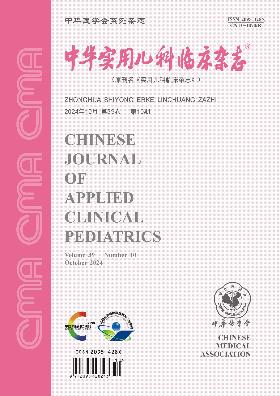远端肾小管酸中毒患儿临床表型与基因型的相关性分析
Q4 Medicine
引用次数: 0
摘要
目的分析6例原发性远端肾小管酸中毒(dRTA)患儿临床表型与基因型的相关性。方法收集2017年11月至2019年8月在华中科技大学同济医学院武汉儿童医院确诊为dRTA的6例患儿的临床资料,并进行相关辅助检查,评估其生长发育情况。保留静脉全血进行Trio全外显子组测序,应用全谱遗传病准确诊断云平台进行系统的数据筛选和分析。通过Sanger测序检查可疑突变,然后通过软件预测蛋白质的作用。结果6例患儿临床表现、体征及辅助检查结果均符合dRTA诊断标准,以生长发育迟缓为突出特征。1例膝关节外翻,1例骨质疏松,辅助检查结果均为尿碱性、代谢性酸中毒、低血钾。3例患儿有肾钙质沉着症,2例患儿有肾结石。6例患者父母均正常,无表型。在4例患者中发现SLC4A1基因突变,包括1例报告纯合常染色体隐性错义突变的儿童(c。2102G>A, p.G701D),患有dRTA和溶血性贫血,以及3例报告的新生杂合常染色体显性错义突变的儿童(c。1766G>A, p.R589H, c.1765C>T, p.R589C),其诊断年龄与肾脏影像学异常有关。1例患者发现ATPV1B1基因复合杂合常染色体隐性突变,为新型杂合错义突变(1153C>A, p.P385T和c. 806C >t, p.P269L)。在1例ATPV0A4基因中发现了一种新的纯合常染色体隐性错义突变(c。1899C>A, p.Y633X, 2008)。结论SLC4A1、ATP6V1B1、ATP6V0A4基因突变是原发性dRTA的主要原因,其表型与突变特征和基因型有关。对疑似dRTA的患者应进行基因检测,进行早期分子诊断,提高临床表型筛查和个体化治疗水平。关键词:远端肾小管酸中毒;基因突变;SLC4A1基因;ATP6V1B1基因;ATP6V0A4基因本文章由计算机程序翻译,如有差异,请以英文原文为准。
Analysis of correlation between clinical phenotypes and genotypes in children with distal renal tubular acidosis
Objective
To analyze the correlation between clinical phenotypes and genotypes in 6 children with primary distal renal tubular acidosis (dRTA).
Methods
The clinical data of 6 children confirmed as dRTA in Wuhan Children′s Hospital, Tongji Medical College, Huazhong University of Science & Technology from November 2017 to August 2019 were collected, and related auxiliary examination was performed to assess their growth and development.The venous whole blood was reserved for Trio whole exome sequencing, and full spectrum genetic disease accurate diagnosis cloud platform was applied to systematic data screening and analysis.The suspected mutations were checked by Sanger sequencing, and then the role of protein was predicted by software.
Results
Clinical manifestations, signs and auxiliary examination results of the 6 children accorded with the diagnostic criteria of dRTA, and the prominent characteristics was growth retardation.One case had knee valgus, one had osteoporosis, and the auxiliary examination results showed that both of them had alkaline urine, metabolic acidosis, and hypokalemia.Three children had nephrocalcinosis, and 2 children had nephrolithiasis.The parents of the 6 patients were all normal without phenotypes.Mutations in the SLC4A1 gene were identified in 4 patients, including 1 child with a reported homozygous autosomal recessive missense mutation(c.2102G>A, p.G701D), who had dRTA and hemolytic anemia, and 3 children with the reported de novo heterozygous autosomal dominant missense mutation(c.1766G>A, p.R589H, c.1765C>T, p.R589C), whose age at diagnosis was related to abnormal renal imaging.Compound heterozygous autosomal recessive mutations in the ATPV1B1 gene were identified in 1 patient, and they were novel heterozygous missense mutations (1153C>A, p.P385T and c. 806C>T, p.P269L). A novel homozygous autosomal recessive missense mutation was identified in 1 patient in the ATPV0A4 gene(c.1899C>A, p.Y633X, 208).
Conclusions
Mutations in SLC4A1, ATP6V1B1, ATP6V0A4 genes are identified as the main causes of the primary dRTA, and the phenotypes was related to the mutation features and genotypes.Genetic test should be conducted on patients suspected as dRTA for early molecular diagnosis, thereby improving clinical phenotypic screening and individualized treatment.
Key words:
Distal renal tubular acidosis; Genetic mutation; SLC4A1 gene; ATP6V1B1 gene; ATP6V0A4 gene
求助全文
通过发布文献求助,成功后即可免费获取论文全文。
去求助
来源期刊

中华实用儿科临床杂志
Medicine-Pediatrics, Perinatology and Child Health
CiteScore
0.60
自引率
0.00%
发文量
14243
期刊介绍:
Chinese Journal of Applied Clinical Pediatrics ( semi-monthly ) is a core journal of paediatrics under the supervision of China Association for Science and Technology, sponsored by Chinese Medical Association and undertaken by Xinxiang Medical College. Founded in 1986, it is openly circulated both at home and abroad. The journal has several columns, such as Expert Forum, Experimental Research and Paediatric Surgery, which are mainly for paediatric medical workers and medical researchers in hospitals. Its purpose is to reflect the new theories and technologies in paediatric medicine and scientific research at home and abroad, and to promote academic exchanges.
Chinese Journal of Applied Clinical Pediatrics is a source journal of China Science Citation Database (CSCD), a core journal of Peking University, a source journal of Chinese science and technology paper statistics (China Science and Technology Core Journals), a core academic journal of RCCSE, a high-quality scientific and technical journal of China, a high-quality scientific and technical journal of China Association for Science and Technology, and a high-quality scientific and technical journal of China Biomedical Science and Technology Association. We have been published in China Biomedical Literature Database (SinoMed), China Knowledge Network, Wanfang Data Knowledge Service Platform, China Academic Journal Abstracts, Scopus Database, Chemical Abstracts (USA), Japan Science and Technology Agency (JSTA) Database, Copernicus Abstracts (Poland), Abstracts of the Centre for Agricultural and Biological Sciences (CABS) of the United Kingdom, Cambridge Scientific Abstracts ProQuest Database, WHO Medical Journal of the Western Pacific Region (WMPR), and WHO Medical Journal of the Western Pacific Region (WMPR) of the United States. We have been included in dozens of authoritative databases at home and abroad, such as WHO Western Pacific Region Index of Medicine (WPRIM), Ullrich's Guide to Periodicals, and so on.
 求助内容:
求助内容: 应助结果提醒方式:
应助结果提醒方式:


